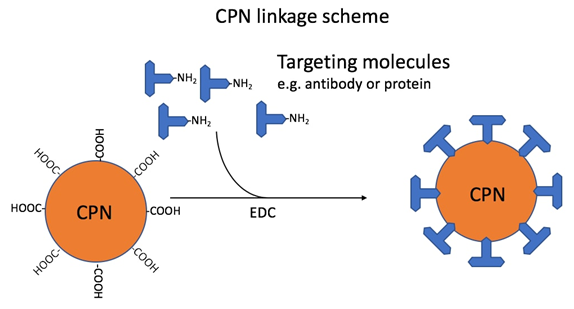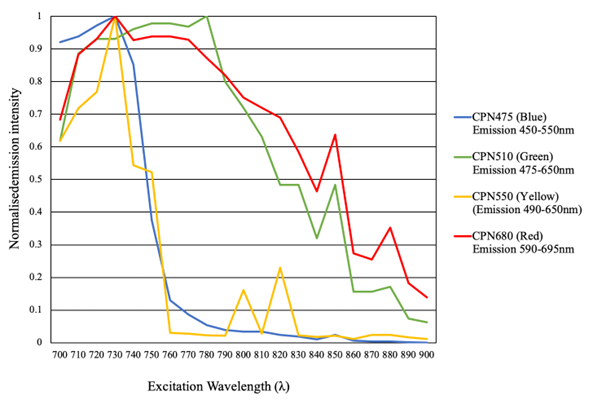Iron oxide incorporated conjugated polymer nanoparticles, or Conjugated Polymer Nanoparticles (CPNs), are extremely luminous nanoparticles composed of a semiconductor light emitting polymer (LEP) core encased inside a biocompatible surfactant.
These advanced molecular bioimaging probes outshine other labeling agents due to their exceptional fluorescent properties. Their brightness stems from outstanding extinction coefficients and excellent photo-, thermo-, and chemical stability.
Furthermore, CPNs are non-toxic and compatible with live cell systems. Additionally, their core includes iron oxide, enabling magnetic manipulation and making them excellent for multi-modal MRI imaging. Refer to Table 1 for a full list of CPN properties.
CPNs emit fluorescence between 420 nm and 680 nm, covering visible spectrum wavelengths. This broad range suits various applications like flow cytometry, immunohistochemistry, ELISA, and lateral flow devices. CPNs match standard filter sets and laser lines.
These methods utilize surface-accessible carboxyl groups to attach various molecules such as antibodies, proteins, streptavidin, and nucleic acids (refer to Figure 1).

Figure 1. Linkage scheme: CPNs linked via carboxyl groups to amino groups on targeting molecules, such as antibodies. This reaction is mediated by the use of 1-ethyl-3-(3-dimethylaminopropyl) carbodiimide (EDC). The ratio used in the standard linkage protocol would attach approximately 40 antibody IgG to each CPN. Image Credit: Merck
Application versatility
The intense fluorescence, stability, and versatility of CPNs render them exceptionally practical and applicable in a wide range of life sciences applications. They demonstrate the ability to enhance various techniques, as depicted in Figure 2.
- Fluorescence Microscopy (high content screening, live cell tracking, and 3-D cell imaging)
- Immunohistochemistry and Immunocytochemistry
- Flow Cytometry
- Rapid Diagnostic Tests (RDTs)
- Tissue Imaging
- 2-Photon Imaging
- NIR Imaging

Figure 2. Versatility in a wide range of applications. A) Fluorescence microscopy. HEK293T cell membranes labeled with Cat. No. 905038.9 B) Rapid diagnostic tests with CPN-based rapid diagnostic test strip. Multiple particles can be used simultaneously on one strip for multiple diagnoses.12,13 C) Z-Stack microscopy. HeLa cells stained with Cat. No. 904996 (red) and nuclei stain (DAPI, blue).9 D) Tissue staining using microscopy with UV surface excitation optical section imaging system. Structures can be labeled in paraffin-embedded tissue using Cat. No. 905038 (yellow). E) Flow cytometry. Cat. No. 905038 showing labeling of 50% subpopulation of CD-4 positive cells in flow cytometry.5,9,17 Image Credit: Merck
CPNs possess unique photonic properties due to their conjugated polymer core. Their brightness and photostability make them highly valuable for applications like two/multi-photon microscopy, as confirmed by experimental validation (see Figure 3).

Figure 3. 2-Photon microscopy. Excitation 700–900 nm. Emission CPN 475, Cat. No. 905054(blue), CPN 510, Cat. No. 905038 (green), CPN 550, Cat. No. 905046 (yellow), CPN 680, Cat. No. 904996 (red). Image Credit: Merck
Materials
Fluorescence lambdaem
Source: Merck
EDC conjugation kit for iron oxide (II, III) nanoparticles
Application
Iron oxide nanoparticles are magnetic single crystals and can be used as magnetic resonance imaging contrast reagents for in-vivo imaging, drug delivery vehicles, hyperthermia generators for therapy, adjuvants for vaccines, and magnetic sensing probes for in-vitro diagnostics.
Ocean NanoTech now offers carboxyl terminated iron oxide nanocrystals with diameters ranging from 10 nm to 30 nm in a user-friendly kit format. This allows researchers to easily link their preferred proteins or ligands to these nanoparticles.
The kit includes enough materials for at least five conjugation reactions, using 1 mg of iron oxide nanoparticles in each reaction. The nanoparticles are activated with carbodiimide and N-hydroxysuccinimide, and then linked to pre-existing amino groups.
Material
Source: Merck
| . |
. |
 |
EDC Conjugation Kit for Iron Oxide (II, III) Nanoparticles 15 nm, carboxylic acid functionalized, 5 mg/mL |
 |
EDC Conjugation Kit for Iron Oxide (II, III) Nanoparticles 20 nm, carboxylic acid functionalized, 5 mg/mL |
 |
EDC Conjugation Kit for Iron Oxide (II, III) Nanoparticles 25 nm, carboxylic acid functionalized, 5 mg/mL |
 |
EDC Conjugation Kit for Iron Oxide (II, III) Nanoparticles 30 nm, carboxylic acid functionalized, 5 mg/mL |
 |
EDC Conjugation Kit for Iron Oxide (III) Nanoparticles 5 nm, carboxylic acid functionalized, 5 mg/mL |
 |
EDC Conjugation Kit for Iron Oxide (III) Nanoparticles 10 nm, carboxylic acid functionalized, 5 mg/mL |